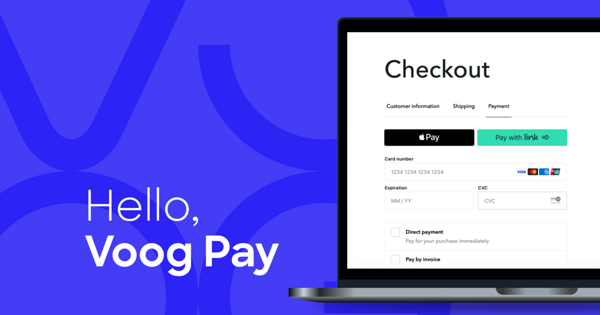Last year, we updated our homepage and website to make full use of the features and design elements that we’ve added to Voog. Now, we’ve also updated our own blog (that had got stuck on an older design for way too long).
Voog is one of the best platforms out there for building gorgeous blogs and homepages. So it is only natural that we use it ourselves as well.
Why you should have a blog of your own on Voog?
There are many benefits to running a blog.
First of all, it is a great channel to connect to your site’s visitors, educate them and show them what it is that you actually do. And how you do it. This allows you to show that actual humans are working in your company and people are not just interacting with a brand.
For example, Playtech has built a blog just like that on Voog.
A blog can also be a channel, where you teach people how to use your products and services. It is a superb tool for customer services, where you can write out longer answers to the most common question your customers have. For example, Cleveron has a blog page that offers in-depth news about their industry and services.
A well-written blog also shows that you are an expert in your field and know what you are doing. This gives you a good networking opportunity as proof of your knowledge makes it easier to connect with other people who can help you expand your business. A blog is also something potential hires look at when deciding if they would like to join your team.
Having a blog is also important for SEO purposes as it lets you answer questions people are searching for on Google and attract new people to your website. Statistics show that people who reach your site through organic traffic, are the most likely to make a purchase.
Optimizing your site for SEO is a science that takes a long time to master but anyone can follow the basic principles of SEO:
- Provide useful content
- Write on the topics that interest your readers
- Prefer longer blog posts to a shorter one
- Share your post on social media and other channels
You can find more articles on how to optimize your website from our site as well. And Voog has a built-in SEO tool to help you further.
How to set up a blog in Voog?
Setting up a blog on Voog is as easy as it can be. It takes less than 15 minutes. Like any other feature of Voog, our blog designs are fully customizable and easy to use. Meaning, you don’t have to be an IT expert to set the blog up.
Using Voog takes no special training. Anyone can easily and cheaply set up a blog that reflects their personal brand. Everything on Voog can be done right here in your browser.
We hope to keep our blog updated to give you the most valuable information about building and designing web pages and online shops. And blogs.
We’ll also share industry news and insights that inspire and show off our great client’s case studies.
We hope our new blog inspires you to try out blogging yourself. And if you are ready to build your own website, you’ll sign up for Voog. It’s free to try out.
Best practices of blogging
If you write about something you know enough about, and if you do it in a way that everyone can understand and enjoy, you’ve got yourself a great blog post. How do you get there? As we say, as long as you stick to a few key principles, you’ve got this. Let’s take a look at the most important tips to write a perfect blog post. It’s our guide to how to write a blog post, for beginners and improvers alike.
We’re assuming you want to write this for a blog related to your business, but the truth is that our advice is universal, and so swap out a few words, and you can use it to create a brilliant blog about anything from baking to birdwatching, and anything in between.
1. Decide what you would want to know about your product as a reader
The most common mistake made by blogs is to write from the writer’s point of view, not the reader’s. By this, I mean that you can’t just write what you think you’d find interesting — because you’re not writing for yourself, you’re writing for an audience, and hopefully a wide one.
As an example, don’t write a blog post on what you’ve been doing this week, with no context or relevance to anything in the outside world. Write something you think a member of the public, stumbling upon your blog, would want to see. A post about what you’ve been doing this week, in most cases, could be made interesting, but only if put in a wider context. That’s how to write the best blog ever.
For example, why not change “what I’ve been doing this week” to “what I’ve learned about _____ by doing ______”? Not only does taking out the “this week” part mean that the post doesn’t have such a limited shelf-life, but also you can be sure that more people will connect with a blog post that looks at what can be learned from an activity.
Let’s take a concrete example. If your company repairs computers, you CAN write a blog post about which computers you have fixed this week, and what problems they had when they came in — but how can you make that inspiring and link it in with people who may be doing different jobs to you? How about if you explore, in your post, what brings you pleasure in fixing computers, and how a recent batch of computers in for repair reconnected you with your passion for your job? That’s something everyone can relate to — we all want to do jobs that excite us, and it’s fun to read about someone who does.
2. Choose the right platform for your blog
This is often the first thing that people do, but it probably shouldn’t be; for most people, the message is more important than the medium. Or the Medium, as it might be. Once you’ve written your first post, that’s the time to decide where to put it. That’s because each blogging platform appeals to a different kind of blog.
If you want to write blog posts that mostly focus on the text, and which are not very image-heavy, Medium, which also promises to share the best posts through its homepage and through daily newsletters, is an option. For more experimental blogs where pictures are regularly used and there is not a pressing need to be relentlessly professional, Tumblr is okay. For people who are adept at HTML coding, WordPress is worth a look.
It goes without saying that we recommend Voog as a platform on which to run your blog; we use it, and we feel it brings us good results with a high level of presentation. Voog also has several templates designed specifically with bloggers in mind, and the easy-to-use, drag-and-drop interface means you’re not going to waste valuable business time fiddling around with page margins or title fonts — it’s all ready for you, and it’s guaranteed to look beautiful, whoever’s using it.
With all that said, it’s up to you to find the best way to express your thoughts. For some people, it might be that your visual images are the most important things — in this case, be sure to choose a template and a blogging platform that allows your pictures to shine as you know they should.
3. Do proper research
If you’re blogging on a new subject to you, or if you’re blogging on something on which you are a renowned expert, the same rule applies: make sure you’ve done your homework. This is because if you have properly researched a subject, and it’s clear you’re an expert on it, that expertise will be there for all your audience to see, as you write blog posts readers love.
Again, think of this from the point of view of the reader: do you want to read a post by someone who knows as much as you do, or by someone who can teach you something new? We all want to be informed, and if you keep your tone as neutral as possible, and let the readers know you don’t think you’re better than them, you’re more likely to be an expert they enjoy reading.
4. Find a compelling topic and stick to it
The other matter to think about is how to keep your readers interested once they’re reading your blog. It’s much easier to gain and retain an audience while keeping a strong theme running through all your posts; be sure to identify what it is that your blog is actually supposed to be about, and only vary that slightly from then on.
Again coming back to that example of the computer repair company, if your business is all about fixing computers, that doesn’t mean that all your blog posts have to be directly about fixing computers. You can also look at how computers have become more reliable over time, at the changing nature of technical issues on modern computers, or about ways to keep a computer running reliably for longer. Follow this kind of strategy, and you stand a chance of being viewed as an industry expert.
5. Come up with a specific, targeted headline
The killer headline is what can make or break your blog post. Choose an unappealing headline, and readers won’t even get to see the great piece of work you’ve written. Write something that over-sells your article, promising too much, and you’ll be dismissed as providing “clickbait” by your readers, and they won’t trust you again. That’s why it’s crucial to get the headline right.
The perfect headline has a mixture of a medium length (five to eight words usually), one or two superlatives, and something a little unconventional or unexpected.
Puns or plays on words can be funny, of course, but over-use them, and everyone will come to expect them. Similarly, listicles (such as this one — articles who headlines start with, and that are divided up by, a number) are fine to a point but mix them in with other kinds of article, and vary how you write headlines about them. The key is moderation, as with everything, and also not writing everything to shock.
For great ideas on headlines that catch the eye, we recommend Buzzfeed, the king when it comes to those headers that you have to click on, and also other similar sites like tech-oriented site Mashable, which is another that gets its audience to believe that the best article is one they haven’t read yet.
Your key to a rip-roaring headline is the Coschedule Headline Analyzer, which will give you honest feedback, as well as a percentage, showing how good your headline is, and how likely it is to get attention. Use it, for free, here.
Whatever your blog is about, follow the steps above telling you how to write the perfect business or personal blog post, and you’re sure to craft a memorable and worthwhile post. If you have any questions about how to display your great new content, talk to us!










